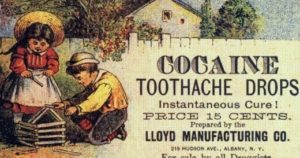The Future of Physician Prescribing: Part I -Stemming The Tide of Addictive Narcotics in the 19th Century

Mike Magee
To understand the evolution of prescription medication in the US, you have to go back to the early 1800’s in Europe. In 1827, Germany was the first country to commercially produce morphine. Some three decades later, their product, in the form of pills, was being distributed in the millions to Civil War soldiers in the US. As with WWI and WWII, soldiers returned addicted to these and other substances, and triggered a series of actions including regulatory attempts to slow the wave of addiction, and a series of licit and illicit actions by those with a financial interest in taking advantage of the trade.
In the late 1800’s, there was open trade, through secret-formula, “patent medicines”, of a wide range of addictive substances from morphine to heroin to cannabis to opiates to cocaine. These were readily available through respected distribution chains. For example, morphine and cocaine, with injection kits, were available in the 1897 Sears Roebuck catalog, and addictive ingredients could be found even in baby teething medications. Derivative products appeared as a potential substitute for more addictive compounds. For example, it is said that John Pemberton, the inventor of the famous formula for CocaCola, which originally contained cocaine, was a morphine addicted Civil War veteran, who was attempting to create a drink that would help addicts resist the urge for morphine.
The government had been attempting to at least catalog the growing nation’s medicines since 1820 when they first established the quasi-governmental U.S. Pharmacopeia. By mid-century, it was clear that they were losing the battle to manage the influx of dangerous and adulterated drugs. In 1848, Congress passed the Drug Importation Act, designed to empower U.S. Customs to inspect incoming drugs and destroy those that were dangerous or adulterated. Science was emerging in parallel, so that by 1862, Lincoln appointed the first chemist to head up the Department of Agriculture. By 1880, the department’s Bureau of Chemistry began to agitate for new food and drug laws.
In 1883, a new chief chemist was appointed named Harvey W. Wiley. FDA historians call him the “Crusading Chemist” and “Father of the Pure Food and Drugs Act”. He served in this role until 1912. His first achievement was the 1902 Biologic Controls Act that targeted the safety of vaccines and serums after a well-publicized series of deaths in 1901 in children who received a diphtheria vaccine derived from horses infected with tetanus. In response, the 1902 Act directed the department to assure the safe development and use of vaccines, and also appropriated funds to Dr. Wiley to study food safety.
By 1906, there was enough public support to pass the Pure Food and Drug Act. It outlawed the interstate commerce of food, drinks and drugs that were mislabeled, branded or adulterated. This was essentially a “truth in labeling” law, arming federal agents to inspect substances, seize product, and penalize offenders. Any of 10 substances considered “addictive” or “dangerous” had to appear on the labels. Also the labels had to list “active ingredients” and these had to fall within the boundaries of “purity levels” as determined by the U.S. Pharmacopeia.
Over the next ten years, concerns grew unabated about the spread and impact of addictive substances, which continued to be widely available and utilized by men and women. Popular magazines and newspapers were filled with stories of “Chinamen” in Opium Dens and JAMA warned on June 23, 1900 of an impending problem of “negroes in some parts of the South are reported as being addicted to a new form of vice”. By 1914, the reality of an increasingly addicted American public, both men and women, combined with fictional stories igniting racial prejudice led to the passage of the Harrison Narcotic Act. Its primary function was to get a handle on the legal distribution of narcotics in the U.S. The law made it illegal to distribute or purchase any of the substances on this list without an order or prescription “in the course of professional practice only” from a licensed physician. It was widely interpreted to prohibit physicians from prescribing narcotics to patients to support and maintain their addictions. Physicians were arrested for violations, and some were imprisoned.
This act established the practice of codifying, approving and tracking the trade between doctor, pharmacist and patient. It’s original intent was not to empower physicians, but rather, in a limited and targeted manner, cut off the flow of addictive substances to the American public. The use of prescriptions to define treatment regiments for individual patients and instructions to pharmacists gradually spread to other products, even though such prescriptions were not technically required.
_______________________________________________
Part II: Prescription Drugs vs. Over-The-Counter (OTC) Drugs


